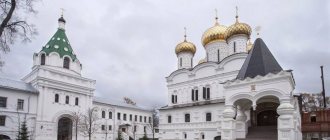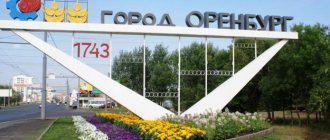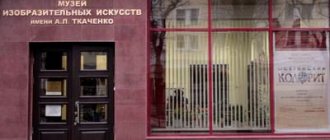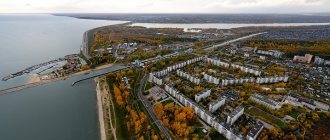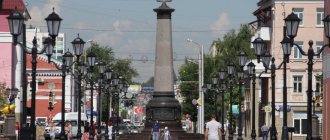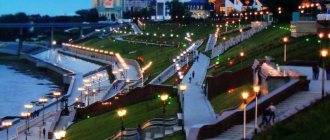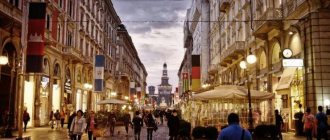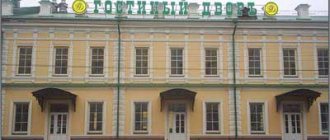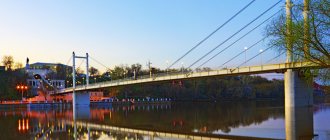Orenburg is one of the cities located on the border of Europe and Asia. Its construction was necessary to open and control roads to Asia.
The location of the fortress city was chosen three times. They even said about this city that it was conceived three times and born once. Finally, in 1743, the Orenburg expedition led by the economist and geographer V.N. Tatishchev , representative of the St. Petersburg Academy of Sciences P.I. Rychkalov and Admiral I.I. Neplyueva founded the city on Red Mountain near the confluence of the Yaik River and the Sakmara River . But its name was given from the Or River , with which the first construction site of the city was connected.
Before we set off to explore the city, we need to go to the Orenburg tourist information center . It is located on Sovetskaya Street 27. The 8 best objects for excursion are indicated there and interesting information about them is given. When visiting these attractions, put elegant stamps in your passport! Vladimir Bobrov worked on them . All the stamps turned out completely different! If you fill out your passport completely, you can receive a gift at the tourist information center! And at the end of the trip you will understand that the passport is the traveler’s real trophy!
What 17 attractions of Orenburg would be interesting to visit in one day?
Cable car
In 2006, a cable car was opened Orenburg , which makes it possible to travel from Europe to Asia . Its length is 233 meters. Passengers travel in cozy translucent cabins. This project even took the status of “The most comfortable cable car in Russia” . The speed of your movement through the air will be 3 m/s, so during the flight passengers have time to take pictures of the river, bridge and embankment from a height of 70 meters.
Drama Theater named after M. Gorky
The M. Gorky Drama Theater is a great landmark of Orenburg. In 2006, the famous building turned exactly 150 years old. It was at this time that the theater was reconstructed, after which the architectural style did not lose its primitive beauty. Therefore, every tourist should go here! The history of the drama theater is connected with the life and work of famous actors who performed on the big stage. Today, the theater’s activities have not lost its relevance and on its stage you can watch the best performances in the country.
Toy railway
It just seems like the little train and fairytale stations are made for children. In Orenburg, the Children's Railway is the most adult attraction! The road was built not only for skiing, but also to transport parents to country health camps. The railway line runs along the Ural River . Very picturesque landscapes alternate with brightly decorated stations. I recommend everyone to take a ride, not just tourists with children.
What to bring as a souvenir
From Orenburg you can bring as a gift not only banal souvenirs, but also more interesting things:
- The scarf is famous all over the world because it is knitted from special fluff. There is a factory for their production here. But it is much better to purchase a hand-knitted product. Down shawls are sold in city markets.
- Knitted garments. In addition to scarf products, the factory produces socks, mittens and hats that can withstand low temperatures.
- Felt boots are made in factories, or craftsmen hand-felt shoes from sheep's wool. At local bazaars, such products are decorated with embroidery.
- Melons have been grown on these lands since the 19th century. In the warm season, melons and watermelons are sold at every turn. And to buy them cheaper and larger, you should go to Sol-Iletsk.
- Malachite and jasper products. In the eastern part of the Orenburg region. The mountains are high, and jasper is mined in them, and malachite deposits are located in neighboring regions.
- The symbols of FC Orenburg will delight its fans with various items with the football logos of this team.
Most travelers can easily find Orenburg on a map of Russia. He deserves high praise for his caring attitude towards ancient monuments and maintaining the cultural values of the Ural region. A trip to this city will give tourists many positive impressions.
Article design: Mila Friedan
Museum of Orenburg History
The Orenburg History Museum is located next to the cable car . It is easy to see as the building resembles a castle. The tower and the clock on it look especially impressive. It was built in 1856 to house the city treasury and archives. Later his purpose changes. Until 1974, the building housed a guardhouse. The museum examines a variety of topics from the life of the city from its construction to the present day.
But the most interesting room tells about the life of A.S. Pushkin in Orenburg . He became the first researcher on the topic of the Pugachev movement and the Peasant War of 1773-1775 . For this, the poet comes to the Southern Urals . He visited nearby villages and talked with those who witnessed those events. Here he came up with the idea of writing The Captain's Daughter .
6. Mall Armada
The largest shopping center in Orenburg, where everyone who wants to do shopping or have fun should go! On the territory of the building there are 370 different shops, entertainment facilities, and places for recreation. This is where the most popular brands of clothing, jewelry, household appliances and much more are collected. People specifically travel to Orenburg to visit the shopping center.
Elizabeth Gate
While walking along the embankment, go to the Elizabeth Gate . This is one of the symbols of the city! The history of their appearance is connected with the Bashkir uprisings in the Orenburg lands in 1755. Then the governor of Orenburg I.I. Neplyuev heroically suppressed the Bashkir uprising. In memory of this, Empress Elizabeth gives a gate , which she orders to be installed at the exit from the city, towards the steppes, so that all nomads remember the power of the Russian army . Over time, the gate collapsed. Their fragments can be viewed in the local history museum . And in 2008, a copy of them was installed on the embankment.
Architectural and monumental landmarks
On the map of Russia in its southern part, Orenburg stretches over an area of 260 km2, which has a large number of architectural landmarks and monuments.
Monument to the valiant Soviet soldiers who defended Peace
A memorial symbol called “Eternal glory to those who defended the world” stands on Pobeda Avenue in the park named after. Guskova poses as a five-pointed star.
It symbolizes the fact that from one generation to another, local residents pass on the memory of the immortal feat of their forefathers.
Monument “The Valor of the Defenders of the Fatherland, Immortal Glory”
On the street Marshal Zhukov, near the military registration and enlistment office building there is a monument called “The Valor of the Defenders of the Motherland, Immortal Glory.” It is presented in the form of the top of a tank.
Monument to V.I. Lenin
The monument to V. Lenin stands in the park of the same name. Soon after Ilyich’s death, Orenburg residents began to raise money for the construction of a new hydroelectric power station, which they wanted to name after the leader of the proletariat.
When the required amount was collected, it turned out that Orenburg did not have the appropriate professionals to build the station, and instead it was decided to erect a monument, which was opened in 1925.
Memorial complex "In memory of those who fell during the war"
The obelisk dedicated to the soldiers who died during the Second World War was opened in a solemn ceremony in 2005 in the city of Abdulino. The complex resembles a star with long lower edges that contain the entire structure. The forked ends of the stele rise above the upper star ray; even higher they are connected to each other, where they are decorated with another star.
The height of the monument is about 15 m; at its foot there is a massive marble slab. On its front part there is an eternal flame, and behind it there is a memorial plaque with the carved names of the heroes of the Second World War. The entire surrounding landscaped area has an area of 403 m2.
Monument to the heroes who died in battles for the Soviet Motherland
The monument to the soldiers who died for the Soviet Fatherland is located in the garden named after. Frunze in 1973. This design looks like a huge torch. The massive bowl is supported by 4 columns.
Directly on the vessel there are 6 bas-reliefs on a military theme. At the base of the colonnade the Eternal Flame burns, and the entire complex is bordered by a ribbon on which the name of the monument is embossed. Around the composition there are 6 memorial plaques with carved historical words.
Monument to A. Prokhorenko
In the spring of 2016, a Russian officer took on an airstrike in combat and was posthumously awarded the title of Hero of Russia. Some time later, a monument to A. Prokhorenko, who died in Syria, was unveiled in Orenburg on the street. New.
The officer stands at full height, and with his left hand he holds on to the destroyed column, which means that he died for the liberation of the Syrian city of Palmyra. There are flower beds around the monument.
Monument to M. Jalil
The sculpture of M. Jalil was opened in Orenburg in 1996 on the street. Postnikova. The foundation of the memorial sign is dedicated to the 90th anniversary of the Tatar poet. The monument was cast in Tatarstan and has a mass of 1.5 tons. Jalil is depicted sitting on a boulder with his head slightly turned to the side.
Bust of Sergei Levashov
In the courtyard of secondary school No. 25, located on the street. Turkestanskaya, 8 B installed a bust of the Young Guard S. Levashov, who assembled a radio receiver and with its help received reports from the Sovinformburo. The young man organized and became the leader of an underground Red Guard cell. After severe torture, the Germans threw him alive into a mine.
Obelisk to victims of radiation accidents
A memorial object called “To the Victims of Radiation Accidents” stands in the park at the junction of the street. Novaya and st. Proletarskaya. The obelisk was opened in 2008 and is dedicated to the victims of all radiation disasters.
The sculpture is presented in the form of a structure made of stone and metal. In its center there is a symbol of radiation - a circle divided into 6 sectors. It is surrounded by various avant-garde configurations. The monument is placed on a 30 cm pedestal, and the total height of the obelisk is about 3 m.
Monument to V. Chkalov
A monument to the famous pilot was erected on the bank of the river. The Urals in 1953, although V. Chkalov was never in this city. The sculpture is cast from bronze and placed on a granite pedestal. The total height of the monument is 13 m; behind it there is a staircase leading to the river. Ural.
Gostiny Dvor building
Gostiny Dvor was built to organize areas for the development of trade relations with Asian peoples on the street. Kirova, 13. The building, decorated in the style of classicism, has 2 floors, and at that time about 150 shops could fit here.
Gostiny Dvor is a historical building in Orenburg that is still in operation.
The complex still carries out its immediate tasks - merchant shops have replaced the newest trading pavilions. A major renovation of Gostiny Dvor was done at the beginning of the new century.
Elizabeth Gate
Travelers will find the Elizabeth Gate on the street. Soviet in the park named after. Gagarin. They are 2 large pillars with niches in which there are figures of angels. They are holding a palm branch and a shield in their hands.
The load-bearing parts are connected to each other by a crossbar with a bas-relief. The gate was given to the city by Queen Elizabeth in 1755 and installed before the descent to the river. Ural. Over time, the structure collapsed and in 2008 they were restored using the surviving drawings.
Water tower
In 1904, an original structure was built in Orenburg to purify and deliver water to local residents. The tower was erected in the central part of the city on the street. Gorky, 57, and its appearance causes a sharp contrast with the nearby buildings. The water tower is 28 m high and is currently designated as a site of historical value.
The building is made in a classic style with lancet windows and decorative elements. From the middle of the 20th century. The tower is not used for its intended purpose, and currently it houses public catering outlets and offices. You can get here from 10.00 to 12.00, and on holidays until 4.00.
Fountain "Friendship of Peoples"
There is a unique fountain called “Friendship of Peoples” inside. Its water jets are illuminated by bright lights at night, which makes it festive and elegant. The water feature can be found near Russian, Ukrainian and Kazakh farmsteads.
National village
The Urals is a region where more than 100 nationalities live. Each has its own traditions and values. You can learn about them in the National Village , where the farmsteads of the 10 most numerous peoples living in Orenburg and the region . Here you can get acquainted with Tatar, Bashkir, Kazakh, Russian, Georgian and other cultures. Through cuisine, literature, crafts and everyday life, you will notice the commonalities and differences between the represented peoples.
Entertainment
Cultural complex "National Village"
Address: st. Altayskaya, 3 Opening hours: Tue - Sun 13:00-00:00
The cultural complex contains farmsteads and reflects the originality of the Orenburg area and the diversity of the ethnic group inhabiting it. Each farmstead has an individual style associated with the cultural customs of different peoples.
The history of the complex begins in 2004. The exhibition includes courtyards:
- Armenian and Chuvash housing;
- Belarusian hut;
- German house;
- Mordvinian town;
- Bashkir corner;
- Ukrainian courtyard;
- Kazakh economy;
- Russian village.
You can taste national cuisine, read literature and periodicals, spend the night in a hotel, or go to the bathhouse.
Europe-Asia cable car
Coordinates: Embankment of the Ural River Cost: 50 rubles per adult
You can take a walk over the Ural River by cable car, which is equipped with two closed cabins. From the windows you can clearly see the city's surroundings, the park and the river. Travel time is 5-7 minutes.
Toy railway
Address: st. Kirova, 37 Phone: Website: https://www.dzd-ussr.ru Opening hours: Thu - Sun 9:54 - 16:58 Cost:
- children under 5 years old - free;
- children from 5 to 14 years old - 15 rubles;
- adults from 14 years old - 30 rubles.
The children's railway appeared in Orenburg in 1953. Its length is 5.8 km along the coast. The train makes stops at three stations - Komsomolskaya, Kirovskaya, Dubki.
You can travel by train only in summer; the rest of the time the trains are located at Dubki station.
If you get off at Komsomolskaya station, you will find yourself in the city center at the pedestrian bridge over the Ural River. Kirovskaya station and Dubki will lead to children's recreational camps.
A school for young railway workers has been opened at the Children's Railways. Children are instructed in such professions as driver, switchman, dispatcher and others. In the summer there is practice.
Shawl Museum
The down scarf began to be made in the Orenburg province around the 18th century. The museum displays historical exhibits telling about the emergence and development of this craft. You will experience delight and surprise, because this is a real miracle! A scarf created using ancient technologies can pass through a wedding ring! The secret of its softness and strength is the special fluff provided by local goats. The excursion will be interesting for tourists of any age.
Attractions in the surrounding area
Sorochinskoye Reservoir
Coordinates: 52°24'6.11″N 53°12'31.68″E Website: https://fguusv.ru/
This reservoir appeared on the Sakmara River in the Sochi region in 1976, but was finally put into operation in 2009. The Osmaya and Bolshoy Uran rivers flow into it.
The main function of this artificial reservoir is to regulate the flow of the Sakmara River.
This place is suitable for recreation and fishing.
Sol-Iletsk and Lake Razval
Lake coordinates: 51°09'02.7″N 54°59'58.4″E How to get there: from the regional center of Orenburg, 70 km along the P239 highway south to the border with Kazakhstan. By train - to Iletsk-1 station.
The famous city of the Orenburg region, where many tourists come, is located on the border with Kazakhstan. There are many salt and mud lakes here, the largest of which is Razval.
The history of the city begins with the launch of salt mining in 1744, when the wooden fortress Iletskaya Zashchita was built. In 1865, the fortress was turned into the city of Iletsk. It received its modern name in 1945.
Razval is an artificial lake in the southern part of the city. The water is very salty (200 grams per liter of water) - it does not freeze in winter.
There is no flora or fauna in this ecologically clean reservoir. But it is suitable for the restoration and prevention of skin diseases, the genitourinary system and the respiratory tract.
Lakes in Sol-Iletsk: Teploye, Novoe, Tuzluchnoe, Dunino, Maloe and Bolshoye.
Catherine's Church in Tugustemir
Address: Tyulgansky district, Tugustemir village, st. Tserkovnaya, 5 How to get there: from Orenburg along the P239 highway to P240 to the village of Tugustemir.
During the resettlement of serfs from the Vladimir province at the end of the 18th century, the village of Tugustemir was formed on the river of the same name.
According to legend, in ancient times one Bashkir hunter lost the place where he had set traps. He walked, searched and said: “Tugus-Temir.” Translated it means “Where are my nine pieces of iron?”
In 1852, with donations from government official Viktor Ivanovich Zvenigorodsky, the Church of the Holy Great Martyr Catherine was built. The design of the temple was carried out by Konstantin Andreevich Ton. The facade of the structure was decorated with twelve apostles made of plaster. A 43 m high bell tower was built next door.
Under Soviet rule, church paraphernalia was removed, sculptures of the apostles were destroyed, and the building served as a granary. However, some frescoes have survived to this day. The temple is under reconstruction and is a monument of history and architecture of the 19th century.
Complex "Red Mountain"
Coordinates: 51°49'35.5_N 56°22'20.8_E How to get there: from Orenburg along the street. Krasnoznamenaya towards the street. Marshal Zhukov, then take P336 to Mt.
The tourist complex "Red Mountain" is located on the right bank of Sakmara. The appearance of the mountain is consistent with its name, because it has a characteristic red tint of clay and sandstone on its surface.
This area is notable for the presence of the Belgorod fortress, wooden buildings: houses, mills, churches and others. On their basis, the Museum of the Orenburg Cossacks was built. On the opposite bank is the village of Saraktash, where the Local History Museum with down scarves and the Holy Trinity Convent of Mercy are located.
Landscape Park Luna
Address: Sharlyk district, Luna village How to get there: from Orenburg along the street. Krasnoznamenaya towards the street. Marshala Zhukova, south along the street. Proletarskaya towards the street. Krasnoznamennaya to the village of Luna.
Luna Park was created solely on the initiative of a few residents of the village where it is located. The organizer was Nikolai Fedorovich Zhabin.
Inside the park there is an artificial pond, two wooden houses, a mill, and a gate. You can fish and just relax in nature.
Luna Park is not a tourist attraction, but a private property. You can enter the park with the consent of the owners.
Krasnaya Krucha
Coordinates: 51°28'27″N 54°12'6″E How to get there: from Orenburg to the Chernovsky reservoir 90 km along the P-335 highway towards the Dimitrovsky village.
Krasnaya Krucha is a steep cliff, which mainly consists of red sandstone and other brown rocks. It is located on the Chernovskoye Reservoir and has a depth at its highest point of 18 meters.
The cliff has an intricate patterned shape due to the rock washed by water. Wind and water grind the sandstone, resulting in the formation of numerous natural cavities and niches, pillars and arches.
Krasnaya Krucha is recognized as a unique natural site and is protected at the state level.
Victory Park
In summer in Orenburg it is pleasant to walk around the city. It pleases with greenery and fountains. It can even be a pity to waste time on museums. In this case, I recommend visiting an open-air exhibition of military equipment. It is located in Victory Park . Here you can see tanks, planes, self-propelled guns and even trains. The exposition plays out in a very interesting way. You can climb in the trenches, climb onto a train or sit on a cart. Everywhere there are information signs telling about the exhibit.
Park named after 50th anniversary of the USSR
Great Park named after. The 50th anniversary of the USSR is the pride of Orenburg. It is difficult to meet a resident of this city who has not been to this wonderful place. The park itself is very large and beautiful, there are many attractions (including extreme ones), restaurants, recreation areas and much more. Therefore, if you go here, you can have a fun time. The park has several small ponds where you can feed the birds. Children especially enjoy these walks. Park named after The 50th anniversary of the USSR will give you many unforgettable impressions and beautiful photographs.
Opening hours: Tuesday-Friday from 16 to 23; Saturday, Sunday – 12:00-23:00, Monday – closed.
Museum of Taras Shevchenko
For the 175th anniversary of Orenburg, a museum-guardhouse was opened . Taras Shevchenko was arrested here . The museum is small, but quite realistically reflects the gloomy spirit of the prison premises of the 19th century. There are thick bars on the windows, small cold cells, sparse furnishings.
The formidable guards (wax figures) add realism to the guardhouse. One of the rooms displays the artist’s personal belongings. Museum workers say that Taras Shevchenko violated the emperor’s ban on painting, as he had to devote all his time to military affairs. This is why he ends up here. And even influential friends could not help him. In addition to the permanent exhibition, the museum organizes temporary exhibitions. Most often these are paintings by local artists.
The most beautiful Orenburg caves
The Orenburg region has prepared pleasant surprises for speleologists: in the local mountains there are several caves accessible to travelers. Many of the grottoes have a complex structure, so tourists should take care of their safety before visiting them.
Cave Gift
- Coordinates: 51.456516, 56.597183.
The largest gypsum cave in the region is located in a mountain near the village of Dubensky. The length of the underground labyrinth is 660 meters. “The Gift” consists of several rooms and three levels, the entrance is located at the top. In some places you can come across stalactites and stalagmites.
The halls are always cool; in summer the temperature stays at around 12°C. Visitors to the cave must have suitable equipment: helmet, warm clothing, flashlight. It is safer to travel through the tunnels accompanied by an experienced guide.
Yumaguzinskaya cave
- Coordinates: 51.605182, 57.607272.
The most famous cave in the Orenburg region is hidden in the depths of Mount Beloshapka, located near the village of Yumaguzin. Being at the foot of the mountain, it is difficult to notice the low entrance, buried in thickets of tall grass. Those brave souls who decide to make their way through the inconvenient underground corridor will be rewarded - a spacious hall with ancient fossilized plants and animals on the walls.
Cave "Mosaic"
- Coordinates: 51.375222, 57.090065.
“Mosaic” is one of the many gypsum caves of the Kzyladyr field. Getting into it is not easy: the entrance is low, in winter the underground corridors and rooms freeze, and in the spring they are filled with floods. Tourists usually visit the grotto in dry weather in the summer.
There are beautiful stains on the walls of the cave, and in places there are small stalactites and stalagmites. Amateur speleologists need to wear a helmet to avoid injuring their heads on sharp protrusions, and warm clothing, since the temperature inside does not rise above 14 °C even in the heat.
Holy Caves
- Coordinates: 51.997561, 53.893381.
The caves in the village of Pokrovka have a long history. At the end of the 19th century, Orsky Cossack Zakhary Kartsev settled here, on the banks of the Samara River. The hermit dug a cave for himself, improved the spring that babbled nearby, and spent all his days in fasting, labor and prayer.
People who thirsted for spiritual achievements and salvation were drawn to the righteous man. They also dug caves and settled near Zechariah. Gradually, a community of Christians leading a monastic lifestyle emerged. Over time, the monastery received official status, and Zachary took monastic vows with the name Zosima. Cells and a temple were built in the caves, then the brethren began to build buildings on the surface of the earth.
After the October Revolution, the monastery was closed, and the above-ground buildings were dismantled into bricks. In the 90s, monasticism in Pokrovka began to revive, believers restored the buildings, but the entrance to the caves was found only in 2002.
Today, the grottoes again enter the boundaries of the St. Nicholas Convent; you can get into the dungeon through the Church of the Nativity of John the Baptist. The cold, cramped cells are filled with icons and candles. The nuns themselves conduct tours of the holy caves and talk about the history of the monastery.
You may also be interested in interesting places in individual cities of the Orenburg region - Orsk and Orenburg
House-Museum of the Gagarins
In 1961, Yuri Gagarin flew into space. This was an important event for all humanity. It became especially important for Orenburg , where Gagarin lived for many years. Here he graduated from flight school and found a family in the same city. In the center of the city there is an old merchant mansion, which once housed the Gagarin family , and since 2001 a memorial house-museum . Initially, this was the apartment of Valentina Goryacheva (Gagarina) , but when she married Yuri , the couple lived here for a long time. After moving to Star City , Yuri and Valentina Gagarin periodically visited Orenburg and stayed in this apartment. Most of the items belonged to the astronaut's family, and photographs from the family archive are also presented.
Tower with chimes
In the center of the main street of Orenburg there is a famous landmark of the city - the chimes tower. This building is visited by all tourists. The tower itself was built not so long ago, but during its short existence it managed to become a symbol of Orenburg. The main highlight of the attraction is that under the magnificent chimes there are famous figures that appear when the clock strikes at 12:00 and 17:00. At this time you can see the image of Pushkin A.S., a young lady with a headscarf, a woman with a child, Pugachev and many others.
Space Museum
The Museum of Cosmonautics is located in the flight school where famous pilots of the country trained: Yu. Gagarin , V. Lebedev , Yu. Lonchakov and others. For a long time, the largest exhibit of the museum stood in front of the building - the MiG-15 aircraft Yuri Gagarin flew in 1961 . The school recently celebrated its 95th anniversary. Over its history, it has trained 28 thousand pilots and navigators. Of these, there were 252 Heroes of the Soviet Union, 10 twice Heroes of the Soviet Union and 4 cosmonauts!
The pilots of this school were the first in history to master the skies over the Arctic and Antarctic . In 1963, the first cosmonaut school in the Soviet Union . And then the cosmonautics museum . Part of the collection included personal belongings of Yu. Gagarin and his flight log.
In 1993, the school was disbanded. Within these walls is located the cadet flight school, the first stage of training. The local residents gave the educational institution a funny name: among themselves they call it “letka.”
Springs and waterfalls of the Orenburg region
The Orenburg land is fed by dozens of springs. Local mineral and hydrogen sulfide springs are of great importance for health tourism, and the especially revered consecrated springs attract hundreds of pilgrims.
Hanging springs of Rodnikovka
- Coordinates: 53.982143, 53.491824.
In the vicinity of the village of Nikolkino you can see unusual springs. Countless water springs make their way out of the steep slope of a high red hill and run down in cheerful streams into the Rodnikovka River.
Other streams fall from the steep wall and form small waterfalls. In some places, water flows have washed out small niches in the mountainous banks.
Kondurovsky hydrogen sulfide spring
- Address: s. Kondurovka, Saraktashsky district.
The cold spring near the village of Kondurovka has healing properties due to its high content of hydrogen sulfide. Water has an unpleasant taste and smell, but helps in the treatment of many diseases.
The spring comes out at the foot of the hill, the area around it is practically undeveloped. In 2011, believers consecrated the spring in honor of the icon of the Mother of God “Quick to Hear” and erected a wooden cross of worship next to the stream.
Dmitrievsky hydrogen sulfide spring
- Coordinates: 53.382083, 54.155889.
Another famous hydrogen sulfide mineral spring is located near the village of Dmitrievka, Ponomarevsky district. The spring forms a small round lake with amazingly clear blue water. Local residents surrounded the pond with a fence and organized several descents into the water.
The source remains cold even in hot weather, but neither the temperature nor the specific smell stops tourists who want to take healing baths. Swimming in the lake is good for health, but you must remember the contraindications: for some diseases, such a procedure can only cause harm.
Spring "Kainar"
- Coordinates: 51.229194, 56.671694.
The Belyaevsky district is famous for its springs, perhaps the most visited of them is the mineral spring on the territory of the Burtinskaya Steppe nature reserve. The Turkic name “Kainar” is translated into Russian as “source”.
Mineral water hardly heats up in summer and does not freeze in winter. A stream of the same name flows from the spring, which forms a tiny round pond. Several years ago, the lake was surrounded by wooden sides, and a neat gazebo for relaxation appeared nearby.
"Holy Key"
- Coordinates: 53.441246, 53.311949.
In a gully 5 kilometers from the village of Kuzkino there flows a revered holy spring. The key is located away from the roads, with endless fields stretching around it. The spring is well equipped; it is enclosed in a concrete well, over which a small wooden chapel is erected. The water in the holy spring is always cool and remains fresh for a long time; some believers consider it healing.
The key is sometimes called “Revealed”, as there are legends that saints have appeared in the beam more than once. The spring has been known for more than a hundred years; even in Soviet atheistic times, pilgrims from all over the Orenburg region and neighboring regions came to it. In 1998, the spring was recognized as a hydrological natural monument of regional significance.
Springs village Kiryushkino
- Coordinates: 53.560993, 52.288036.
The springs in the village of Kiryushkino, Buguruslanovsky district, are also considered sacred, but they are revered not by Christians, but by pagan Erzya. The three springs were nicknamed “Vishka Lisma”, “Poksh Lisma” and “Baban Kasha”.
The last source is especially important; its name translated from Erzya means “Babya porridge” - a ritual dish for a pagan holiday. The Erzya used spring water to treat diseases and protect against evil spirits; they sprinkled it on their homes, outbuildings, people and livestock.
Today, residents of surrounding villages still come to the source. A small wooden house is erected above the spring, and life-giving moisture is supplied through a metal pipe.
Silver Spring
- Coordinates: 52.569546, 56.102710.
It is also a fairly well-known spring in the region, where hundreds of vacationers flock. It is located in the Tyulgansky district, near the village of Tugustemir. There is a place to relax next to the source where you can barbecue. The spring water itself here is very cold, icy and, according to unverified sources, it actually contains silver.
Europe-Asia Stele
In 1981, column was installed the Ural River , which can conditionally be considered the Europe-Asia border . Why conditional? You know that scientists do not stop in their research. Once upon a time, in the 18th century, it was believed that the Ural River was a natural border dividing the mainland. But everything changed in the 20th century! Today, geographers have determined that the border runs along a mountain range, a little further from Orenburg .
But in memory of the worldview of the past, a stele was erected. It is visible from the ring road and many city guests entering Orenburg stop in their cars near this sign. From the city center, the stele can be easily reached on foot if you move along the embankment. The area near the obelisk is decorated with flower beds and lanterns. You can come here both during the day and in the evening.
Garden named after Frunze
Be sure to go to the city garden named after. Frunze in Orenburg. This is an amazing place with many sights to see. Upon entering, you can immediately see the famous Mig-17, one of the first fighters during the Cold War. On the territory of “Salute, Victory!” you can see tanks, monuments to heroes, anti-tank guns, mortars, etc. There is a magnificent chapel nearby. In addition, the garden reflects post-war life. On the square you can see tractors, legendary semi-trucks, steam locomotives and much more. If you move in a circle, you can go to the eternal flame and pay tribute to those who died during the war years. And the most important monument of the garden is the intercontinental ballistic missile of the R-36M2 “Voevoda” complex, the length of which reaches 34.3 meters and the weight is 211 tons!
Garden visiting hours: 10:00 – 21:00, closed on Mondays. The entrance is free.
Caravanserai
Typically, a building with this name is intended to accommodate traders with goods. But in Orenburg this complex of buildings was provided for the comfort of the Bashkir military. The fact is that at the beginning of the 19th century, the governor of the Orenburg region decided to create a powerful military force. It included Bashkir military and Ural Cossacks.
As a step of respect for the religion of the Bashkirs, a mosque was built. Construction was carried out at the expense of the city budget, but the Muslims themselves helped prepare the materials. From 1837 to 1846, the complex was built under the leadership of Alexander Bryullov (brother of the famous artist Karl Bryullov ). It consisted of a mosque, a two-story building where the commander of the Bashkir army , a military office and various workshops. From 1865 to 1917 this building became the residence of the Orenburg Governor .
Planetarium
The Orenburg Planetarium is 65 years old. It was the eighth planetarium in the country. Initially, during Soviet times, it was located in the building of the Caravanserai , and in the 1980s it was allocated another building.
From the very first minutes, visitors are immersed in the cosmic world. The hall where events take place is brightly decorated. Planets and various spacecraft are located under the ceiling. The windows also display children's works on space themes. The planetarium offers programs for both children and adults. Most of them take place in the form of lectures and films. Equipment with a rotating dome immerses the viewer in outer space. But if you want to watch a real solar eclipse, you will be asked to go to another room where a powerful telescope is installed. It can easily “deliver” you to the rings of Saturn or to the Milky Way .
Orenburg on the map of Russia
Orenburg on the map of Russia is located in the southern part of the Urals near the border with Kazakhstan. In a city with a population of 564 thousand people. river flows The Urals, the river flows into it nearby. Sakmara.
Orenburg was founded 3 times in different places, but the official date of foundation of the settlement is considered to be 1743. In 1938, the settlement received the name Chkalovo, and its previous name was returned to it 19 years later.
The best ways to get into the city are:
| Kind of transport | Peculiarities |
| Airplane | The airport is located 20 km away. from Orenburg, it is better to get there by bus or minibus |
| Railway | There is an intersection of several railway tracks here, which allows you to get there without transfers. |
| Bus | This regional center has a bus station with suburban and interregional transport links |
| Automobile | The highway connecting Kazan with Akbulak and the direct Moscow road passes through the city. |
Museum of Fine Arts
The Museum of Fine Arts consists of two buildings. The old building, classical style, was built in the 19th century by Mikhail Malakhov . It was intended for the city council and court. During Soviet times, a kindergarten was located here. The second building is modern, transferred to the museum’s collections in 2012.
For those who are interested in the fine arts of our country, visiting the museum will make many discoveries for themselves. Most of the collection is focused on the preservation and development of national culture. Part of the fund is occupied by works by Orenburg artists, as well as decorative and applied art of the Southern Urals .
Churches and Temples
Caravanserai Mosque
Address: Parkovy pr., 6 Phone: Website: https://daura.com/ Opening hours: 8:00 - 19:00
The building was erected in 1838 for the Bashkirs, who stationed their troops on the territory and came to the city for work.
The architect was Alexander Pavlovich Bryullov at the request of the governor of that time, Vasily Alekseevich Perovsky. The design is made in the style of Islamic architecture, its external features resemble an ordinary Bashkir village, and the mosque looks like an elder’s house.
The name of this architectural ensemble does not quite coincide with the meaning of the word “caravanserai” itself - “yard” or “market”, a meeting place between buyer and seller. But the mosque historically was not such a place; Bashkir military leaders were located in it.
Central Cathedral Mosque
Address: st. Rybakovskaya, 98 a Phone: Website: https://dumoo.ru Opening hours: 8:00 - 19:00
The one-story brick building of the Central Mosque was built at the end of the 19th century.
At that time, the region was actively populated by Tatar peoples, so in 1879 the City Duma allocated a site on Konno-Sennaya Square for a new mosque - due to the close location of a Muslim cemetery.
Husainiya Mosque
Address: st. Kirova, 3 Phone: Website: Husainiya.rf Opening hours: 8:00 - 22:30
In Orenburg, the Khusainiya mosque appeared in 1892, thanks to the merchant-philanthropist Akhmed Khusainov.
In the history of the mosque, there were suspensions of its activities with the advent of Soviet power, when its building was transferred to the department of an educational institution, and then to the Ministry of Internal Affairs. With the departure of power, through the common efforts of the parishioners, the decent appearance of the building and its original function were restored.
The mosque hosts Muslim rituals, teaching the basics of Islam and moral education.
Cathedral of St. Nicholas
Address: st. Chkalova, 8 Phone: Website: Nikolskysobor.rf Opening hours: Sun 7:00 - 19:15; Mon - Fri 7:00 - 18:00; Sat 7:00 – 16:00
The foundation stone of the St. Nicholas Cathedral of the Orenburg and Saraktash diocese was carried out in 1883 on the site of a burnt Cossack village at the expense of parishioners. The project was carried out by Vyacheslav Petrovich Sakharov. Consecrated in 1886 by Bishop Benjamin II.
Like many religious buildings, under Soviet rule it was used as a building for secular needs. In 1944 it was opened again, then periodically completed over a long period of time.
There is a Sunday school at the cathedral.
The Tabyn Icon of the Mother of God is kept here.
Church of the Holy Great Martyr Demetrius of Thessalonica
Address: st. Popova, 98 Phone: Website: https://dimitrus.ru Opening hours: 7:00 - 17:00
The history of this Temple begins with the construction of a single-altar church in 1887, the patron of which was Fyodor Petrovich Degtyarev. The church was built in honor of Dmitry of Thessaloniki, the governor of the Greek city of Thessaloniki and an open preacher of the Christian faith.
Over time, the church expanded and became three-altar. In honor of the Great Martyr D. Thessaloniki, the Dormition of the Virgin Mary and the Holy Trinity.
In 2006, a monastery opened here.
Church of the Annunciation of the Blessed Virgin Mary
Address: Sharlykskoye sh., 1 Telephone: ; +79878476255 Website: https://vk.com/hramuarmady Opening hours: Mon-Sat 8:00-20:00; Sun 9:00-20:00
The temple opened and was consecrated by Metropolitan Benjamin in 2016. It is located on a hillock near a shopping mall.
The new building is larger and can accommodate 100-500 people. A Sunday school and a refectory are open at the church.
Services in the temple are performed daily, liturgies on Sundays.
Orenburg Governor's Museum
The appearance of this museum is due to the Orenburg military governor P.P. Sukhtelen . In the middle of the 19th century, he gathers representatives of the scientific world and sets before them the task of systematizing knowledge about the Southern Urals . By this time, the Orenburg region was poorly studied, all materials were scattered. It was supposed to unite them and create a regional museum telling about the botany, geology and zoology of the region.
Among the scientists was V.I. Dahl . He is appointed to the position of corresponding member of the St. Petersburg Academy of Sciences . His tasks included studying the flora and fauna of the Orenburg region . Having lived for almost 10 years in the Southern Urals , he wrote the first textbooks in Russia on zoology and botany. , a “zoological museum” was formed in Orenburg , which laid the foundation for the local history museum . Today, its collection includes more than 100 thousand exhibits. Among them are works of craftsmen of the region, household items, costumes, musical instruments...
Monuments of archeology and paleontology
Orenburg ancient monuments are surprisingly numerous and diverse. Almost the entire territory of the region is dotted with the remains of extinct sea and land animals, and in some corners traces of the first human settlements have survived.
Mount Zmeinaya
- Coordinates: 51.421192, 55.404053.
A small mountain near the village of Belyaevka is not just another peak of the Southern Urals, but a most valuable monument of paleontology. Previously, there were many reptiles in the short grass on the slopes of the hill, so the mountain was dubbed Zmeinaya, although some Orenburg residents call it Khanskaya, or Khanova.
The steep slope is made of giant multi-colored slabs, in which ancient marine animals of the Jurassic period are forever frozen. The mountain has preserved so much diverse fossil fauna that research continues to this day.
Among the fairly common fossils like belemnites and ammonites, there are also rarer ones, for example, the bones of the sea lizard plesiosaur. At the suggestion of scientists, the state took the territory under its protection in order to preserve the precious finds.
Cemetery of pseudo-crocodiles
- Coordinates: 51.593391, 53.647579.
On the outskirts of the village of Rassypnoye there is a deep ravine called Mayachnaya. The slopes of the ravine are fraught with many surprises. At first glance, this is an ordinary hill, but in fact it is a cemetery of ancient animals. Millions of years ago, lakes splashed in its place, in which all kinds of amphibians and reptiles swam. It was here that paleontologists discovered the remains of pseudosuchia, or pseudocrocodiles - the most ancient ancestors of dinosaurs.
These extinct animals resembled large crocodiles; they were distinguished from their descendants by longer vertical limbs. Pseudosuchians moved on land not by crawling, like modern reptiles, but on outstretched legs, like dogs. Bones and even entire skeletons of fossil creatures have been preserved in Rassypnoye. Among the finds is the skull of a labyrinthodont, a lizard-like amphibian from the Mesozoic era.
Åland settlement
- Coordinates: 52.197000, 59.885117.
The existence of traces of an ancient city in the Kvarken region might not have been known if not for a happy accident. In 1987, specialists from Uralaerogeodesy carried out aerial photography in this area. Later, office employee A.E. Puchin, looking at the photographs, drew attention to a strange circle between the Suunduk and Solonchak rivers. Chelyabinsk archaeologists were informed about the curious find, and within a few months the first expedition to the ancient settlement was organized.
Archaeologists planned to carry out excavations, but soon the collapse of the USSR occurred, difficult times came for the whole country, and practically no money was allocated for science. I had to forget about a full-fledged study of the settlement.
The first excavations took place only at the beginning of the 2000s. Experts have established that the Åland settlement arose approximately 4,000 years ago; it was part of the “Country of Cities” system and was similar to the famous Arkaim. Dozens of artifacts have been preserved in the ground, such as tools made of stone, bone and bronze, fragments of pottery, as well as defensive ramparts, ruins of a stone fortress wall and ruins of dwellings.
People's Museum named after General M.G. Chernyaeva
This museum will be of interest to anyone who is interested in history, because it contains exhibits telling about the wars of the 19th-21st centuries. It is very symbolic that the museum is located in a building that was built by Japanese and German prisoners of war in 1948. This is one of the few museums where you can hold exhibits in your hands and take pictures with them.
An interesting object of the museum is the diorama “Berlin. 1945. May " . It was installed for the 70th anniversary of the victory. Standing next to her, the viewer is transported to the roof of the Reichstag and, as if together with our soldiers, sets up the red banner. The museum is open free of charge.

